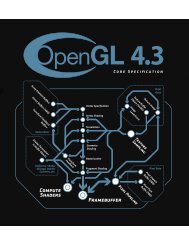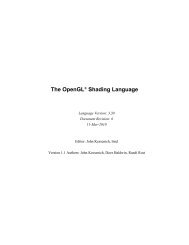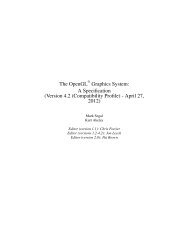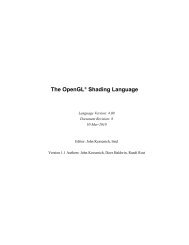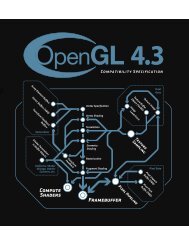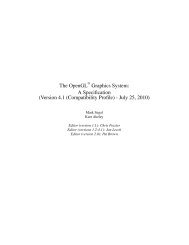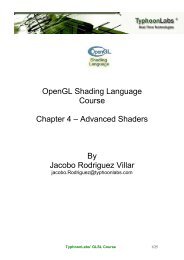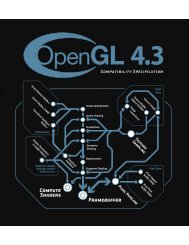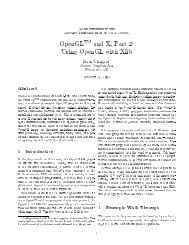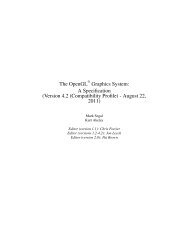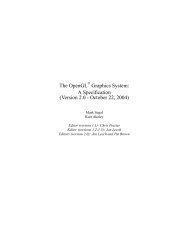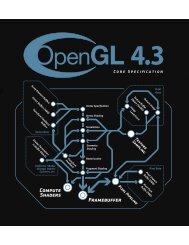Introduction to GLSL - OpenGL
Introduction to GLSL - OpenGL
Introduction to GLSL - OpenGL
Create successful ePaper yourself
Turn your PDF publications into a flip-book with our unique Google optimized e-Paper software.
Shader 'Input' Data<br />
Programmers can write self-contained standalone shaders, which don’t require<br />
any extra data <strong>to</strong> run, in order <strong>to</strong> produce desired results<br />
Shaders (both vertex and fragment) usually obtain some input values, such as<br />
textures, limit and timing values, colors, light positions, tangents, bi-normals,<br />
and pre-computed values, which are used <strong>to</strong> compute the final vertex<br />
position/fragment color for any given surface.<br />
Uniform Variables<br />
Uniform variables can use one of the <strong>GLSL</strong>-defined types. These read-only<br />
values (which should be treated as constants, as they cannot be changed) are<br />
then passed from the host <strong>OpenGL</strong> application <strong>to</strong> the shader.<br />
<strong>GLSL</strong> data type C data<br />
Description<br />
type<br />
bool int Conditional type, taking on values of true or false.<br />
int int Signed integer.<br />
float float Single floating-point scalar.<br />
vec2 float [2] Two component floating-point vec<strong>to</strong>r.<br />
vect3 float [3] Three component floating-point vec<strong>to</strong>r.<br />
vec4 float [4] Four component floating-point vec<strong>to</strong>r.<br />
bvec2 int [2] Two component Boolean vec<strong>to</strong>r.<br />
bvec3 int [3] Three component Boolean vec<strong>to</strong>r.<br />
bvec4 int [4] Four component Boolean vec<strong>to</strong>r.<br />
ivec2 int [2] Two component signed integer vec<strong>to</strong>r.<br />
ivec3 int [3] Three component signed integer vec<strong>to</strong>r.<br />
ivec4 int [4] Four component signed integer vec<strong>to</strong>r.<br />
mat2 float [4] 2×2 floating-point matrix.<br />
mat3 float [9] 3×3 floating-point matrix.<br />
mat4 float [16] 4×4 floating-point matrix.<br />
sampler1D int Handle for accessing a 1D texture.<br />
sampler2D int Handle for accessing a 2D texture.<br />
sampler3D int Handle for accessing a 3D texture.<br />
samplerCube int Handle for accessing a cubemap texture.<br />
sampler1DShadow int Handle for accessing a 1D depth texture with comparison.<br />
sampler2DShadow int Handle for accessing a 2D depth texture with comparison.<br />
TyphoonLabs’ <strong>GLSL</strong> Course 8/29



